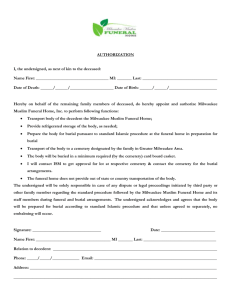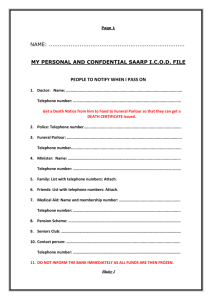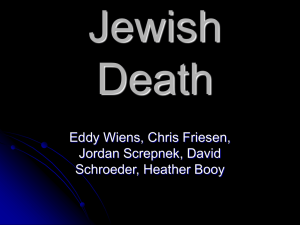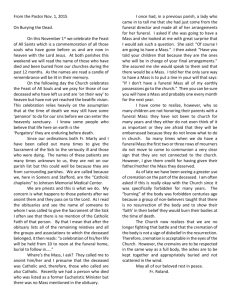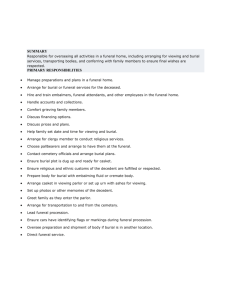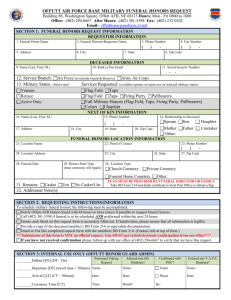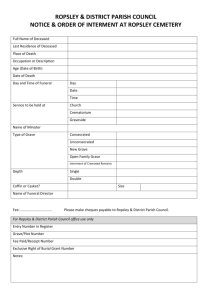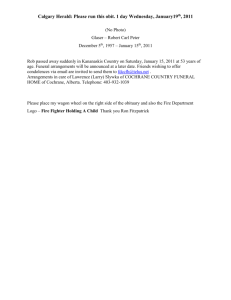Guide to Jewish Funeral Practice
advertisement
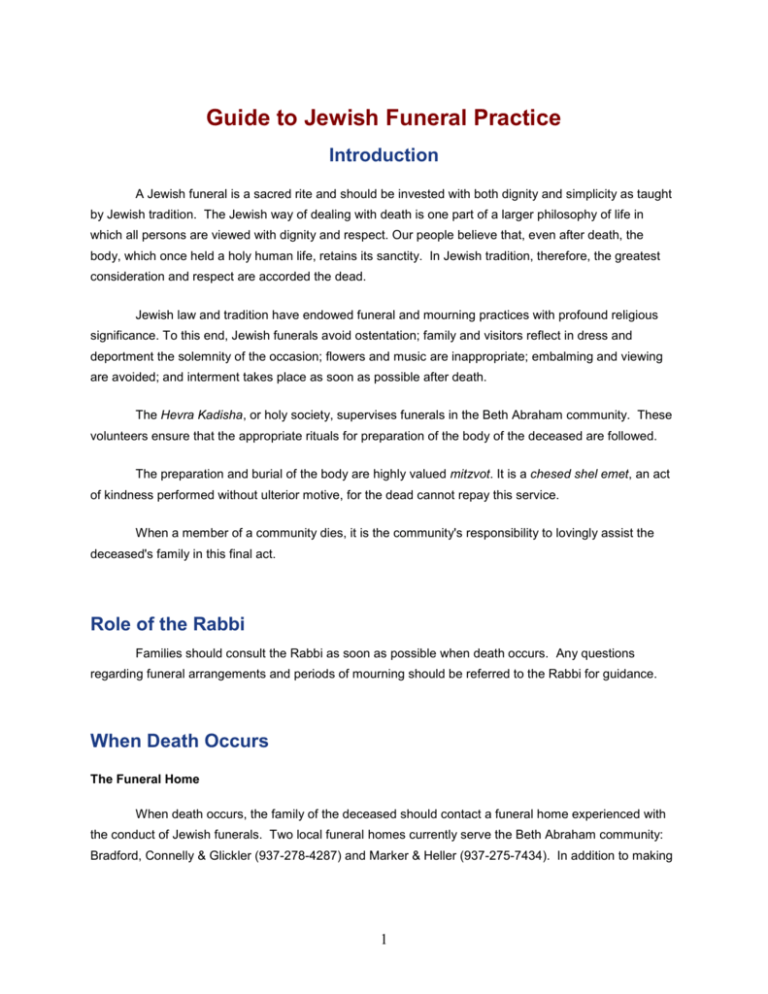
Guide to Jewish Funeral Practice Introduction A Jewish funeral is a sacred rite and should be invested with both dignity and simplicity as taught by Jewish tradition. The Jewish way of dealing with death is one part of a larger philosophy of life in which all persons are viewed with dignity and respect. Our people believe that, even after death, the body, which once held a holy human life, retains its sanctity. In Jewish tradition, therefore, the greatest consideration and respect are accorded the dead. Jewish law and tradition have endowed funeral and mourning practices with profound religious significance. To this end, Jewish funerals avoid ostentation; family and visitors reflect in dress and deportment the solemnity of the occasion; flowers and music are inappropriate; embalming and viewing are avoided; and interment takes place as soon as possible after death. The Hevra Kadisha, or holy society, supervises funerals in the Beth Abraham community. These volunteers ensure that the appropriate rituals for preparation of the body of the deceased are followed. The preparation and burial of the body are highly valued mitzvot. It is a chesed shel emet, an act of kindness performed without ulterior motive, for the dead cannot repay this service. When a member of a community dies, it is the community's responsibility to lovingly assist the deceased's family in this final act. Role of the Rabbi Families should consult the Rabbi as soon as possible when death occurs. Any questions regarding funeral arrangements and periods of mourning should be referred to the Rabbi for guidance. When Death Occurs The Funeral Home When death occurs, the family of the deceased should contact a funeral home experienced with the conduct of Jewish funerals. Two local funeral homes currently serve the Beth Abraham community: Bradford, Connelly & Glickler (937-278-4287) and Marker & Heller (937-275-7434). In addition to making 1 the necessary arrangements for the family, the funeral director will also contact the rabbi, the synagogue, the Hevra Kadisha and the cemetery on the family’s behalf. Time of Funeral and Burial Jewish law requires that burial take place as soon as possible, traditionally within 24 hours of death. Under today’s conditions where family members are widely dispersed geographically, or for other unavoidable circumstances, it is common for burial to be delayed. Burial on Shabbat or festival days is to be avoided. But it should not be delayed longer than necessary. It is also inappropriate to make arrangements on Shabbat itself. Shmirah (Attending to the body) Jewish tradition has mandated that the deceased not be left alone prior to burial. Because of the delay in burial beyond the traditional 24 hour period that is common in our community, this practice is regrettably not easy to fulfill in the Beth Abraham community and has become the exception rather than the standard practice. It is preferable that the shomrim (attendants) be members of the family or friends of the deceased. If the family wishes to fulfill this mitzvah, a request should be made to the Hevra Kadisha through the funeral director, and every effort will be made to find and organize sufficient volunteers. While in attendance on the deceased, Psalms are recited by the shomrim. Aninut - Between Death and Burial Autopsies and organ donation The practice of routine autopsies is contrary to Jewish law, since autopsies are viewed as a desecration of the body. In most cases, when an autopsy is recommended, the family can refuse. But if it is required by law, or if the doctor feels it would yield necessary medical information, autopsy is permissible. Organ donation is an act of pikuach nefesh (saving a life), a great mitzvah, and so may also be viewed as an example of k'vod ha-met (respect for the deceased) which brings healing to the living. Embalming According to Jewish tradition, embalming and the use of cosmetics on the deceased are not permitted. 2 Cremation Cremation is contrary to Jewish tradition. In order to discourage the practice at Beth Abraham, the Rabbi will not officiate at a funeral where cremation is to take place, nor may the sanctuary or chapels of Beth Abraham be used for the service. However, ashes may be interred at the Beth Abraham cemetery, in a private ceremony without the presence of a Rabbi. The urn should have an opening so the ashes come in contact with the earth, and be substantial enough for re-interment if that should ever be necessary. Taharah (Ritual cleansing) and Tachrichim (Shrouds) Jewish law requires that the deceased be cleansed according to a prescribed ritual known as taharah, or ritual cleansing, as an expression of respect. This ritual is carried out by the Hevra Kadisha of Beth Abraham. Following the taharah, the deceased is clothed in plain white shrouds (tachrichim), symbolic of purity and simplicity. A Jewish man is customarily buried wearing a kippah and a tallit, preferably his own, which has been rendered pasul (unfit) by removing one of its fringes. Women whose practice was to wear a tallit may also be buried with one. The Hevra Kadisha also places a small bag in the casket with soil from the Land of Israel, to symbolize our love of Zion and our connection to the entire Jewish people. Mourners who happen to be members of the Hevra Kadisha do not participate in the taharah for their own family members. Aron (Casket) To avoid interference with the natural process of "returning to the earth," Jewish tradition requires that a casket be made entirely of wood. It is preferable that the casket be as simple as possible. This practice emphasizes the equality of all in death, allows the remains to return to the cycle of life and nature as quickly as possible, and keeps cost to a minimum, thus allowing funds to be used to honor the death through charitable contributions that further the values and ideals that were important to the deceased while alive. It is an act of love to select the simplest possible casket. Onen (Bereaved person) Between the time of death and the funeral, an immediate family member of the deceased is called an onen. Specifically, these are the father, mother, son, daughter, brother, sister or spouse of the deceased. The onen is exempt from the performance of all positive mitzvot, such as reciting the three daily services or putting on tefillin. During this time the bereaved must attend to the needs of the deceased, and nothing should distract him or her from these obligations. However, if the funeral is delayed, and all arrangements are attended to by the funeral home, the onen may find comfort in attending prayer services at the synagogue, and should not be discouraged. 3 The Funeral Services Funeral services in the Beth Abraham community are generally held in the chapel at the Beth Abraham cemetery. This is to be encouraged whenever possible in order to ease the transition from the funeral service to the interment, so that mourners and guests do not have to drive from one location to another. In certain cases where the anticipated number of funeral guests cannot be accommodated at the cemetery, the funeral service may be held in the synagogue sanctuary or at a funeral home. If very few guests are expected, a graveside service is sometimes held. The funeral service is brief and simple. It includes the chanting of psalms, a eulogy to honor the deceased, usually given by the rabbi, and El Maleh Rachamim, the traditional memorial prayer. Members of the family or friends may also speak. Often some of the psalms and the memorial prayer are chanted by the Cantor. Viewing the body either publicly or privately is contrary to Jewish tradition. K'riah (Rending the garment) Just before the funeral service begins, the rabbi guides the mourners (parents, spouse, children, and siblings) in the rite of K'riah (rending of garments). This rite consists of reciting a beracha (blessing), then tearing a visible portion of clothing (lapel, pocket, or collar, for example). The torn garment is worn throughout the 7-day mourning period (shivah). The usual practice in the Beth Abraham community is to attach a black ribbon to the clothing, and cut the ribbon instead of the garment. If a mourner wishes to follow the more traditional practice of tearing a garment, the rabbi should be informed in advance. The tearing for parents is on the left side over the heart and for all other relatives on the right side. Pall and pallbearers At a funeral, the casket may be covered with a specially prepared cloth, called a pall, and is borne from the funeral service to the gravesite by family or friends (pallbearers) selected by the mourners. The mourners themselves do not usually perform this function. Carrying the Casket The pallbearers customarily stop seven times while carrying the casket to the grave. They are led by the rabbi, who recites a psalm during the procession. The mourners, family and friends follow the casket as a mark of respect. 4 Fraternal Ceremonies and Military Honors Fraternal ceremonies which interfere with the solemnity of the Jewish funeral service are not appropriate. On the other hand, appropriate military honors for a deceased veteran of the armed forces are acceptable. In most cases this is the presentation of an American flag to the mourners. Burial After arriving at the gravesite and the recitation of a psalm, the casket is lowered into the earth. This allows the mourners to confront their loss, and to face the reality of death. Then the mourners and their comforters, those who knew and loved the deceased person, perform the last act of love by shoveling earth onto the casket. Some have the custom of reversing the shovel. It is also customary to return the shovel directly to the mound of dirt or laying it down, rather than passing it directly to the next person in line. Some say this conveys the lesson that death teaches us, that nothing can really be claimed as one’s own. Were one to hand the shovel directly to the next person, it would suggest handing over an object that belongs to him. Others say the significance of this custom is to avoid passing sorrow from one person to the next. After the casket has been sufficiently covered, the mourners recite the Kaddish for the first time. There is a longer form of Kaddish known as the “burial Kaddish” which is sometimes preferred by very traditional Jews, but it is not well-known to most people, and it is most common in our community to recite the familiar Mourner’s Kaddish. Leaving the cemetery It is customary for the mourners to pass between two rows of people in attendance to receive expressions of consolation, including the traditional greeting: HaMakom yenakhem et’khem betokh sha’ar avelei Tziyon vi-rushalayim ( “May the Holy One comfort you among the mourners for Zion and Jerusalem”). After burial, washing one’s hands when leaving the cemetery or before entering the house of mourning is also traditional. At the House of Mourning Returning from the Cemetery Upon returning from the cemetery to the mourner’s home, it is customary to set up a pitcher of water and some towels outside the front door. Visitors then pour the water on their fingertips to symbolize the difference between a place for the dead (the cemetery) and a place for the living (the home). 5 Memorial Candle The family of the deceased will be provided by the funeral home with a seven-day memorial candle to light in the home upon returning from the funeral. There are no special rituals associated with this candle, but the following prayer may be recited: Out of the depth we cry to You, Adonai. Hear our supplication. A heavy burden has fallen upon this family and this community. We now turn to You, the Source of goodness, for comfort and help. Give us the eyes to see that pain is not Your will, that somewhere there weeps with us One who feels our trouble and knows the suffering of our souls. O Divine Spirit in whose image we are created, we seek the light to dispel the darkness that has overtaken us. Let us find You in the love of family and friends, in the sources of healing that are implanted within all the living, and in the mind that conquers all infirmity and trouble. Grant us the courage to endure what cannot be escaped, and the resolve to go on without bitterness or despair. As this Shiva light burns pure and bright, so may the memory of our dear___________ brighten and purify our lives. Shema Yisrael Adonai Eloheinu Adonai Echad. Hear, O Israel: Adonai is our God, Adonai is One. Seudat havra’a (meal of condolence) It is customary for family and friends to arrange for a seudat havra’a, condolence meal, which traditionally includes round foods such as eggs, which are symbolic of the cycle of life, to be served to the mourners at the shiva house upon their return from the cemetery. At Beth Abraham, the family may be assisted in this by the Serah bat Asher Society. (Serah bat Asher is a figure from rabbinic midrash, a granddaughter of Jacob who had a beautiful and comforting singing voice. When the brothers of Joseph returned from Egypt with the knowledge that Joseph was still alive, they feared that breaking the news to Jacob might overwhelm his aged heart, so they asked Serah to sing the comforting news to him in a gentle way. She was blessed by this act of kindness with eternal life. She still lives today at Beth Abraham as the first comforters of our mourners.) A member of the Serah bat Asher Society will contact the mourners to offer assistance in serving the first meal after the funeral. This will usually be in the shiva house. But in some instances, if the family so wishes – especially if the mourners are from out of town – they may order a catered kosher meal to be served at Beth Abraham Synagogue with the assistance of the Serah bat Asher Society Shivah Shivah is the seven-day period of intensive mourning observed by the immediate family of the deceased, beginning on the day of the burial. It concludes on the morning of the seventh day, following the shacharit (morning) service. During the entire shivah period mourners are encouraged to stay away 6 from work or school, and to remain at home, receiving comfort from friends and family. It is also a time to think about the lasting legacy of the deceased, as well as to contemplate the meaning of life and the manner in which adjustment will be made to the death of the beloved. The house of mourning should reflect solemnity. Mourners should not deem themselves as hosts who are obligated to serve their visitors during the mourning period. It is usual for mirrors in the shivah home to be covered. There are various reasons given for this custom, some of them little more than superstition. But the two most salient reasons are (1) that mirrors may encourage vanity during the time of mourning and (2) that it is forbidden to pray in front of one’s reflection in a mirror, and prayer services are conducted in the house of mourning during shiva. Other customary changes in normal behavior during the period of shiva are for the mourners to refrain from wearing leather shoes, for males to refrain from shaving and haircuts, to refrain from conjugal relations, and to sit on low chairs or stools. Because the mourners do not leave their home during shiva, prayer services are held in the home. In traditional communities, this will occur three times a day, for shacharit, mincha and ma’ariv, including reading from the Torah on Monday and Thursday mornings. In our Beth Abraham community – unless the family itself has sufficient numbers and prayer knowledge to conduct the services on its own the usual custom is to conduct only an evening service in the home after the dinner hour, when friends from the community may join them. Depending on the time of year, this may include mincha as well as ma’ariv. If mourners choose to attend weekday morning services at Beth Abraham during shiva, the weekday minyan will regard itself as if it were in a house of mourning, and will not recite those prayers that are not recited in a house of mourning, such as tachanun. Public mourning observances are suspended on the Shabbat in view of the belief that the sanctity and serenity of this day supersedes personal grief. Mourners are permitted, and encouraged, to attend Shabbat services; but they are not given an aliyah, may not conduct services, and they do not display the k'riah publicly. The major festivals terminate shivah. (For details consult the Rabbi.) Since Judaism teaches that the feeling of loss of a human life is not limited to the descendant’s family alone, but is shared by the entire community, it is customary for the name of the deceased to be recalled at the Shabbat service after the funeral. Shloshim (Thirty Days after Burial) During the thirty days following burial, after the observance of shivah, mourners return to work and activities but refrain from public entertainment or social activities. The k'riah is customarily worn during shloshim. In place of home services, mourners participate in synagogue services daily and recite the Mourner’s Kaddish with a minyan. For relatives other than parents, the period of mourning concludes at the end of shloshim. 7 Shanna (Twelve months) For the first eleven Hebrew months following the funeral, children continue to recite the Mourner’s Kaddish for their parents – daily if possible, but at least weekly at Shabbat services - and continue to avoid celebrations and parties for the full year. Although not obligated to do so, mourners of other relatives often choose to say Kaddish for this extended period as well. Unveiling After the conclusion of shloshim, arrangements should be made for the setting of a monument at the gravesite. An unveiling ceremony may be scheduled with the rabbi, or the family may wish to conduct this brief, simple service themselves. The rabbi can provide appropriate materials. There is no mandated time for the unveiling, and it is generally scheduled sometime between the conclusion of shloshim and the first yahrzeit, at a time that is convenient for the family to assemble. Yahrzeit (Anniversary of death) The Kaddish is recited each year on the Hebrew calendar anniversary of death. It is customary to light a yahrzeit (24 hour) candle and to donate tzedakah on the anniversary. The synagogue will notify you several weeks in advance of the Hebrew date of the yahrzeit. Yizkor (Memorial prayers) The Yizkor is recited on Yom Kippur, Sh'mini Atzeret, the eighth day of Pesach; and the second day of Shavuot. A yahrzeit candle is customarily lit on each of these occasions. 7. Miscellaneous Kohanim - Priests - There are special provisions related to the attendance of kohanim at a funeral. Consult the Rabbi. Flowers - Friends and associates of the deceased who wish to express condolences should be encouraged to contribute to a tzedakah fund important to the deceased or the family. Nichum Avaylim: Condolence calls - Condolence calls to comfort the mourner should be made after the funeral, during the shivah period, except on Shabbat. 8 Limbs - Limbs must be buried, if not interred previously, with the rest of the body. If organs are to be used for transplantation, the rest of the body must be buried promptly. If willed to an organ bank, then the remainder of the body is to be buried. Burial is required of limbs removed from a patient who survives. Miscarriages - Burial may be required for fetal remains. The Rabbi should be consulted. Stillborn – Burial is required. The Rabbi should be consulted. Adar - The yahrzeit of a person who died during the month of Adar in a regular year is observed in a leap year during Adar I. Similarly, there are other special cases involving the yahrzeit of a person who died on the thirtieth day of Marheshvan, Kislev or First Adar, all of which are dates which do not occur every year. In all such circumstances, the Rabbi should be consulted to determine the correct yahrzeit date. Intermarriage - An intermarried Jew is allowed to be buried in a Jewish cemetery. A Rabbi may not officiate in any way at the funeral of a Jew who is intermarried and will be buried in a cemetery of another faith group. Suicide – Although in principle a suicide may not be buried in a Jewish cemetery, a suicide considered to be the result of mental illness does not disqualify a Jew from burial in a Jewish cemetery. Based upon the Rabbi's knowledge of an individual who has committed suicide, the Rabbi determines if burying the individual in a Jewish cemetery is appropriate. In general the rabbinic mandate is to view such cases with leniency and compassion. Pre-Planning - Advance purchase of gravesites, as well as prepayment of funeral home expenses, is recommended. Purchasers of gravesites in the Beth Abraham cemetery are reminded that under the terms of their purchase they must be current paid-up members of Beth Abraham at the time of death in order to be buried in the synagogue cemetery. It is urged that designated relatives be provided with necessary information in advance of death to direct decision-making about the funeral in accordance with the traditions and wishes of the deceased. The Committee on Jewish Law and Standards of the Rabbinical Assembly has prepared useful material on Living Wills which should be utilized by those engaged in advance planning. This brochure is based on the “Guide to Jewish Funeral Practice” published by the Committee on Congregational Standards of The United Synagogue of Conservative Judaism. It has been modified in 2011 by Rabbi Barsky to reflect the practices of Beth Abraham Synagogue, 305 Sugar Camp Circle, Dayton, OH 45409 9
